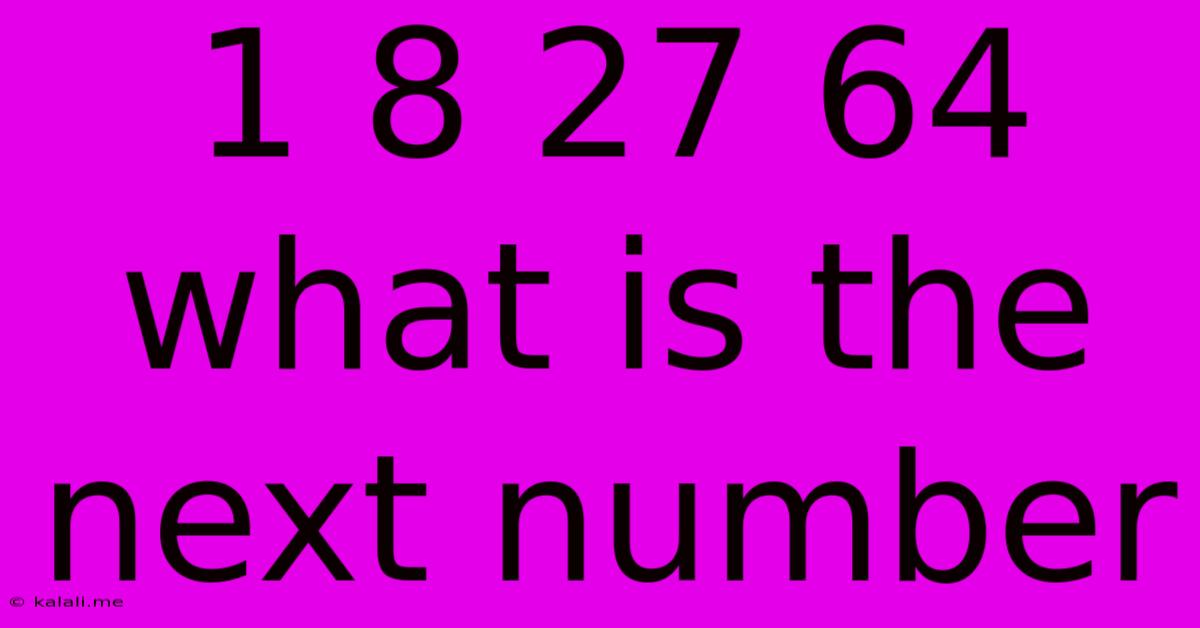1 8 27 64 What Is The Next Number
Kalali
Jun 14, 2025 · 2 min read

Table of Contents
1, 8, 27, 64... What's the Next Number in This Sequence? Unlocking the Pattern
This seemingly simple sequence of numbers – 1, 8, 27, 64 – hides a fascinating mathematical pattern. Understanding this pattern allows us to not only find the next number but also to appreciate the elegance of mathematical relationships. This article will explore the sequence, reveal the underlying pattern, and demonstrate how to predict future numbers in the series. We'll also look at some related concepts to deepen your understanding.
Unveiling the Cube Pattern
The key to understanding this number sequence lies in recognizing that each number is a perfect cube. Let's break it down:
- 1 = 1³ (1 cubed, or 1 x 1 x 1)
- 8 = 2³ (2 cubed, or 2 x 2 x 2)
- 27 = 3³ (3 cubed, or 3 x 3 x 3)
- 64 = 4³ (4 cubed, or 4 x 4 x 4)
See the pattern? Each number is the cube of a consecutive integer.
Predicting the Next Number
Following the established pattern, the next number in the sequence would be 5 cubed:
- 125 = 5³ (5 cubed, or 5 x 5 x 5)
Therefore, the answer is 125.
Expanding on the Concept: Perfect Cubes and Number Sequences
Understanding perfect cubes is a fundamental concept in mathematics with applications in various fields. Recognizing patterns in number sequences is a valuable skill, essential for problem-solving and critical thinking. This specific sequence is a simple yet effective illustration of how to identify and extrapolate patterns to predict future values.
Further Exploration:
- Higher-order Cubes: You can continue this sequence indefinitely by calculating the cubes of higher integers (6³, 7³, 8³, and so on).
- Other Number Sequences: Explore other types of number sequences, such as arithmetic sequences (where there's a constant difference between consecutive terms) or geometric sequences (where there's a constant ratio between consecutive terms). Learning to identify different patterns enhances your mathematical intuition.
- Mathematical Applications: Perfect cubes and number sequences have applications in various mathematical areas, including algebra, calculus, and number theory.
This seemingly simple puzzle provides a great introduction to mathematical pattern recognition. By understanding the underlying principle – the perfect cubes – we can confidently predict future numbers in this sequence and apply this knowledge to other mathematical problems. Remember, the key is to look for the underlying relationship between the numbers!
Latest Posts
Latest Posts
-
Which Of The Following Secrete Hydrochloric Acid
Jun 14, 2025
-
The Total Number Of Lobes In Both Lungs Is
Jun 14, 2025
-
Which Of The Following Is Not Associated With Animal Cells
Jun 14, 2025
-
What Are The Prime Factors Of 14
Jun 14, 2025
-
What Is The First Step In Respiration
Jun 14, 2025
Related Post
Thank you for visiting our website which covers about 1 8 27 64 What Is The Next Number . We hope the information provided has been useful to you. Feel free to contact us if you have any questions or need further assistance. See you next time and don't miss to bookmark.